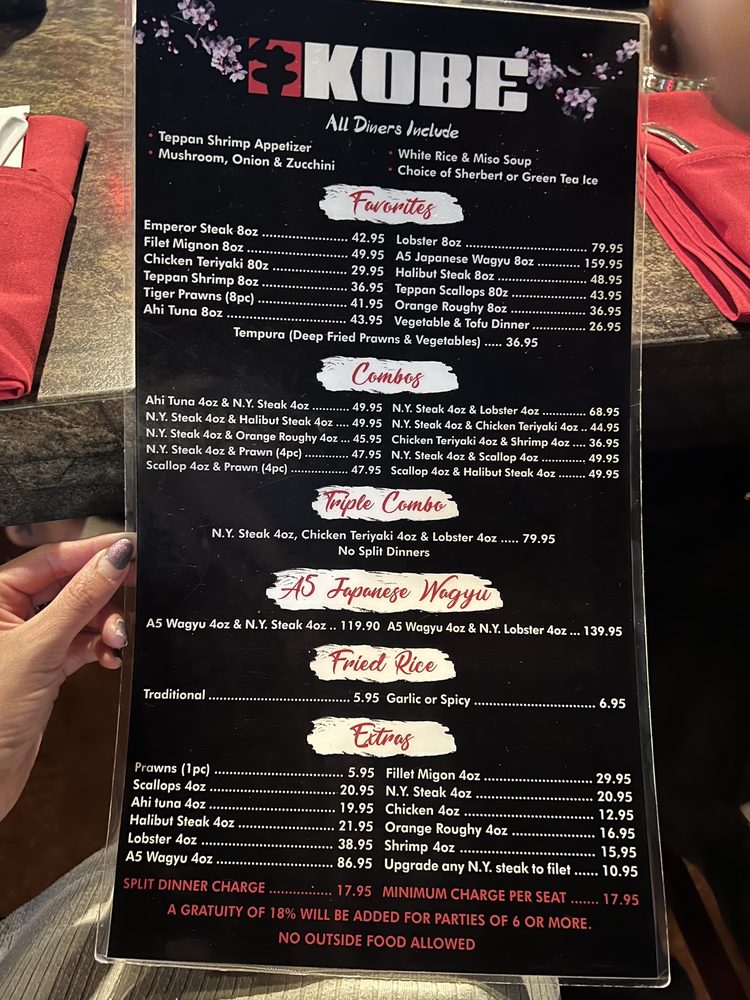Kobe Japanese Steak And Seafood House Menu

The sizzling sounds of teppanyaki, the flash of knives, and the communal dining experience have long defined Kobe Japanese Steak and Seafood House. But beneath the spectacle lies a menu undergoing subtle yet significant shifts, prompting discussion among loyal patrons and newcomers alike.
This article delves into the current state of the Kobe Japanese Steak and Seafood House menu, examining recent modifications, popular dishes, pricing strategies, and the overall dining experience offered. We will explore how these changes reflect evolving consumer preferences, supply chain challenges, and the competitive landscape of the restaurant industry. Understanding these factors provides crucial context for both diners and industry observers.
A Legacy of Hibachi: The Foundation of the Kobe Menu
For decades, Kobe Japanese Steak and Seafood House has built its reputation on the interactive hibachi dining experience. Guests are seated around a large, flat grill where a skilled chef prepares their meal with theatrical flair.
The traditional menu typically features a choice of protein – steak (often filet mignon or New York strip), chicken, shrimp, scallops, or lobster – accompanied by grilled vegetables, fried rice, and noodles.
Signature sauces, like the ginger and creamy mustard, are also integral components of the Kobe experience.
Menu Modifications: Navigating Change
Recent observations suggest that Kobe Japanese Steak and Seafood House menus are experiencing gradual alterations.
Some locations have reported subtle price increases, reflecting rising costs of ingredients and labor. While these price adjustments may not be immediately noticeable, they can impact the overall value proposition of dining at Kobe.
In a statement released on their social media page, Kobe acknowledged "the need to adapt to market pressures while maintaining our commitment to quality."
Another change revolves around menu diversification. While the core hibachi offerings remain, some Kobe locations are experimenting with sushi rolls, appetizers, and other non-hibachi items.
This expansion may aim to attract a broader customer base and cater to those seeking lighter or quicker meal options.
However, it also raises questions about whether this diversification will dilute the restaurant's core identity.
Popular Dishes and the Dining Experience
Despite the menu modifications, certain dishes continue to be Kobe's mainstays. The filet mignon, known for its tenderness and flavor, remains a popular choice.
The hibachi shrimp, often prepared with a generous amount of butter and garlic, also enjoys strong customer loyalty.
The communal seating and interactive cooking create a unique dining atmosphere, particularly appealing for groups and special occasions.
"The experience is what keeps us coming back," says regular patron Sarah Miller. "The food is good, but it's the show that makes it special."
Beyond the Food: Ambiance and Service
The Kobe dining experience extends beyond the food itself. The restaurant's ambiance, often characterized by dim lighting, Japanese-inspired decor, and the constant sizzle of the grills, contributes to the overall atmosphere.
The skill and personality of the hibachi chef also play a crucial role.
Customers often remember their chef's jokes, knife skills, and ability to engage the entire table, shaping their overall impression of Kobe.
Pricing and Value Proposition
Pricing at Kobe Japanese Steak and Seafood House varies depending on location and menu selection.
Hibachi entrees typically fall within the mid-range to high-end price category, placing Kobe in a competitive segment of the casual dining market.
The "dinner and a show" aspect helps justify the price point for many customers, but value-conscious diners may seek alternatives.
Some online reviews suggest that the perceived value has declined slightly in recent years due to rising prices and smaller portion sizes.
These concerns highlight the importance of maintaining a balance between cost management and customer satisfaction.
Kobe must carefully manage its pricing strategy to remain competitive while preserving its brand image.
Looking Ahead: Adapting to the Future
The restaurant industry is constantly evolving, and Kobe Japanese Steak and Seafood House faces several challenges and opportunities moving forward.
Maintaining consistency across different locations is crucial for preserving brand integrity.
Further innovation in menu offerings and dining experiences could attract new customers and retain existing ones.
Competition from other hibachi restaurants and Asian-inspired eateries is intensifying.
Kobe must differentiate itself through exceptional service, high-quality ingredients, and a memorable dining experience.
By focusing on these elements, Kobe Japanese Steak and Seafood House can continue to thrive and maintain its position as a popular dining destination.


















